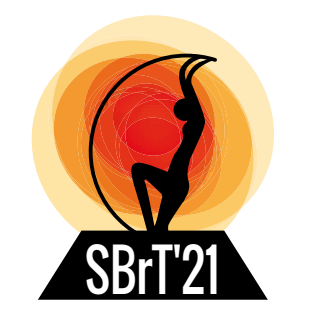
XXXIX Simpósio Brasileiro de Telecomunicações e Processamento de Sinais

Análise de um Sensor SPCE de Nanopartículas pelo Acoplamento dos Métodos Multimodal e PGF
André Felipe Cruz, Geisielen C Seth, Yago G da Conceição, Nadson Welkson de Souza, Tommaso Del Rosso, Victor Dmitriev, Karlo Queiroz Costa
DOI: 10.14209/sbrt.2021.1570727328
Keywords: Sensor SPCE Plasmônica Método Multimodal Funções de Green
Abstract
Neste artigo apresentamos uma análise eletromagnética de um sensor SPCE (Surface Plasmon Coupled Emision) acoplado a um arranjo de nanopartículas Core-Shell, excitado por uma fonte óptica monocromática. Para essa análise propomos utilizar o método Multimodal acoplado ao método PGF (Periodic Green's Function), sobre os modos de Floquet, para descrever os campos na estrutura do sensor. Os resultados mostram a excitação do modo SPCE em função do ângulo de incidência da fonte monocromática, e da concentração de nanopartículas na amostra sensoriada. Por fim, verificamos que a resposta do sensor é insensível a baixas variações do ângulo de incidência do laser.Download
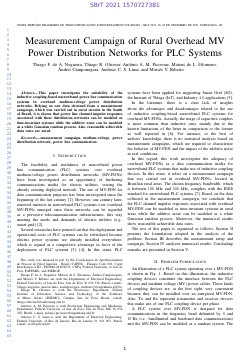
Measurement Campaign of Rural Overhead MV Power Distribution Networks for PLC Systems
Thiago Nogueira, Thiago Oliveira, Antonio A. M. Picorone, Mateus Filomeno, Ândrei Camponogara, Antônio Lima, Moises Vidal Ribeiro
DOI: 10.14209/sbrt.2021.1570727381
Keywords: measurement campaign medium-voltage power distribution network power line communication
Abstract
This paper investigates the suitability of the inductive coupling-based narrowband power line communication systems in overhead medium-voltage power distribution networks. Relying on raw data obtained from a measurement campaign, which was carried out in rural circuits in the South of Brazil, it is shown that power line channel impulse responses associated with these distribution networks can be modeled as time-invariant systems while the additive noise can be modeled as a white Gaussian random process. Also, reasonable achievable data rates are noted.Download
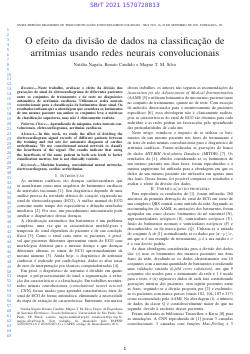
O efeito da divisão de dados na classificação de arritmias usando redes neurais convolucionais
Natália Nagata, Renato Candido, Magno T. M. Silva
DOI: 10.14209/sbrt.2021.1570728813
Keywords: Machine learning convolutional neural networks electrocardiogram cardiac arrhythmias
Abstract
In this work, we study the effect of dividing the electrocardiogram signal records of different patients between the training and test sets for automatic diagnosis of cardiac arrhythmias. We use convolutional neural network to classify the heartbeats of the signal. The results indicate that using the heartbeats of the same patient in both sets leads to better classification metrics, but is not clinically realistic.Download

Fair Adaptive Power Allocation for Cell-Free Massive MIMO Systems
Juno Saraiva, Roberto P. Antonioli, Gabor Fodor, Francisco Rafael Marques Lima, Walter da Cruz Freitas Jr., Yuri C. B. Silva
DOI: 10.14209/sbrt.2021.1570729915
Keywords: Cell-free massive MIMO Power allocation Fairness Iterative optimization
Abstract
This paper investigates cell-free massive multiple input multiple output systems with a particular focus on downlink power allocation strategies. Our analysis considers channel estimation errors, where the access points (APs) acquire channel state information by means of uplink pilots sent by the users. In particular, we focus on the downlink power optimization for the maximization of the minimum signal to interference-plus-noise ratio (SINR) subject to per-AP power constraints. First, we present an existing optimal iterative solution for benchmarking purposes. Then, we propose an efficient solution with low computational cost to tackle the considered optimization problem. Interestingly, the proposed solution has a scalar parameter that can be controlled to adjust its main objective to either maximize the minimum SINR or to maximize the spectral efficiency. Through numerical results we show that our solution is effective in providing fairness and achieving high spectral efficiency in the system. Furthermore, unlike existing solutions, our solution can be executed in a non-iterative fashion with negligible performance loss.Download
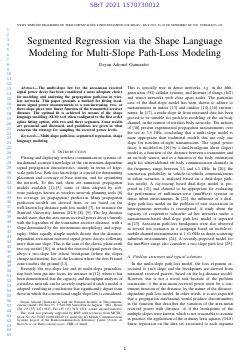
Segmented Regression via the Shape Language Modeling for Multi-Slope Path-Loss Modeling
Dayan A. Guimarães
DOI: 10.14209/sbrt.2021.1570730012
Keywords: Multi-slope path-loss Segmented regression Shape language modeling
Abstract
The multi-slope law for the area-mean received signal power decay has been considered a more adequate choice for modeling and analyzing the propagation path-loss in wireless networks. This paper presents a method for fitting local-mean signal power measurements to a non-increasing, two- or three-slope piecewise linear function of the transmitter-receiver distance. The optimal fit is achieved by means of the shape language modeling (SLM) tool when configured to the first order spline fitting option, with two and three segments. Some results are presented and discussed, and guidelines are given in what concerns the strategy for sampling the received power levels.Download
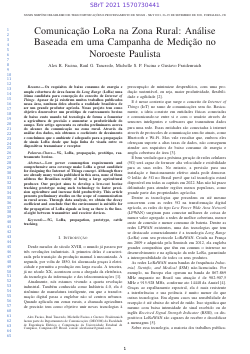
Comunicação LoRa na Zona Rural: Análise Baseada em uma Campanha de Medição no Noroeste Paulista
Alex Rodrigo Facina, Raul Tancredo, Michelle Soares Pereira Facina, Gustavo Fraidenraich
DOI: 10.14209/sbrt.2021.1570730441
Keywords:
Abstract
Os requisitos de baixo consumo de energia e ampla cobertura de área fazem do \textit{Long Range} (LoRa) uma ótima candidata para concepção do conceito de \textit{Internet of Things}. Apesar de já existirem muitos trabalhos publicados nessa área, nenhum deles aborda a realidade brasileira de ser um grande produtor agrícola. Nosso projeto tem como objetivo desenvolver um protótipo de rastreamento bovino de baixo custo usando tal tecnologia de forma a fomentar a agricultura de precisão e aumentar a produtividade do campo. Este artigo apresenta os estudos preliminares acerca do alcance da comunicação na zona rural. Através da análise dos dados, nós obtemos o coeficiente de decaimento e concluímos que o ambiente é adequado para a propagação de sinais LoRa desde que haja linha de visada entre os dispositivos transmissor e receptor.Download
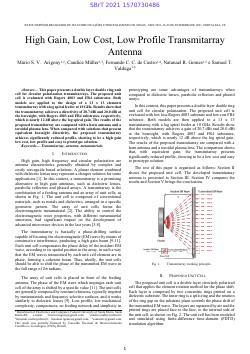
High Gain, Low Cost, Low Profile Transmitarray Antenna
Mário Arigony, Candice Muller, Fernando de Castro, Natanael Gomes, Samuel Tumelero Valduga
DOI: 10.14209/sbrt.2021.1570730486
Keywords: Transmitarray Antenna Metamaterials
Abstract
This paper presents a double layer double ring unit cell for circular polarization transmitarrays. The proposed unit cell is evaluated with Rogers 4003 and FR4 substrates. Both models are applied to the design of a 13 x 13 elements transmitarray with a log spiral feeder at 10 GHz. Results show that the transmitarray achieves a directivity of 20.7 dBi and 20.0dBi at the boresight, with Rogers 4003 and FR4 substrates, respectively, which is nearly 12 dB above the log spiral gain. The results of the proposed transmitarray are compared with a horn antenna and a toroidal plasma lens. When compared with solutions that present equivalent boresight directivity, the proposed transmitarray achieves significantly reduced profile, showing to be a high gain low cost, low profile and easy to prototype solution.Download
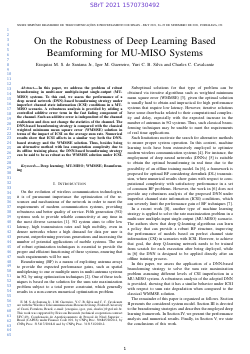
On the Robustness of Deep Learning Based Beamforming for MU-MISO Systems
Ezequias de Santana Jr, Igor M. Guerreiro, Yuri C. B. Silva, Charles Casimiro Cavalcante
DOI: 10.14209/sbrt.2021.1570730492
Keywords: Deep learning WMMSE MU-MISO Beamforming
Abstract
In this paper, we address the problem of robust beamforming in multi-user multiple-input single-output (MU-MISO) systems. To this end, we assess the performance of a deep neural network (DNN)-based beamforming strategy under imperfect channel state information (ICSI) conditions in a MU-MISO scenario. A robustness analysis is provided by adding a controlled additive error term in the fast fading component of the channel. Such an additive error is independent of the channel realization and does not change the statistics of the channel. The DNN-based beamforming strategy is compared with the classical weighted minimum mean square error (WMMSE) solution in terms of the impact of ICSI on the average sum rate. Numerical results show that ICSI affects in a similar way both the DNN-based strategy and the WMMSE solution. Thus, besides being an alternative method with less computation complexity due to its offline training phase, the DNN-based beamforming strategy can be said to be as robust as the WMMSE solution under ICSI.Download
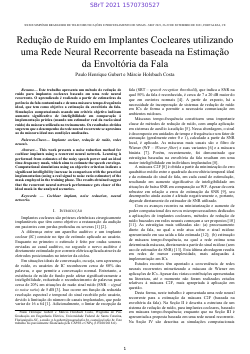
Redução de Ruído em Implantes Cocleares utilizando uma Rede Neural Recorrente baseada na Estimação da Envoltória da Fala
Paulo H Gubert, Marcio H Costa
DOI: 10.14209/sbrt.2021.1570730527
Keywords: Implante coclear redução de ruído redes neurais aprendizado de máquina
Abstract
Este trabalho apresenta um método de redução de ruído para implantes cocleares baseado em uma rede neural recorrente. O aprendizado é realizado a partir de estimativas da potência da fala contaminada e de uma máscara tempo-frequência ideal, que tem como objetivo a estimação da envoltória da fala. Simulações computacionais usando um critério objetivo indicam aumento significativo da inteligibilidade da fala em comparação à implementação prática (usando um estimador real da razão sinal ruído) da máscara utilizada no treinamento. Os resultados obtidos sugerem que o desempenho da rede neural recorrente se aproxima ao da máscara ideal, nas condições analisadas.Download
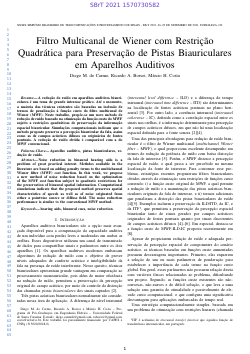
Filtro Multicanal de Wiener com Restrição Quadrática para Preservação de Pistas Biauriculares em Aparelhos Auditivos
Diego Marques do Carmo, Ricardo Augusto Borsoi, Marcio H Costa
DOI: 10.14209/sbrt.2021.1570730582
Keywords: Aparelho auditivo redução de ruído pistas biauriculares
Abstract
A redução de ruído em aparelhos auditivos biauriculares é um tema de grande interesse prático. Até o momento, a maioria das técnicas existente são baseadas em adicionar termos de penalização à função custo do filtro multicanal de Wiener (MWF). Neste trabalho, propõe-se um novo método de redução de ruído baseado na otimização da função custo do MWF sujeito a restrições quadráticas de preservação da informação espacial biauricular. Simulações computacionais indicam que o método proposto preserva a percepção biauricular da fala, assim como as de campos acústicos direcionais ou difusos. A redução de ruído obtida é comparável com a do MWF convencional.Download